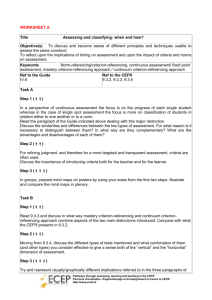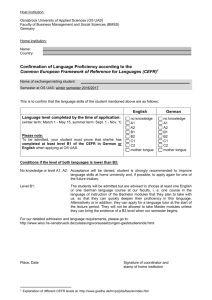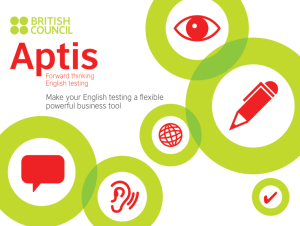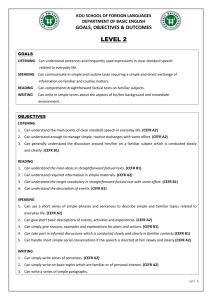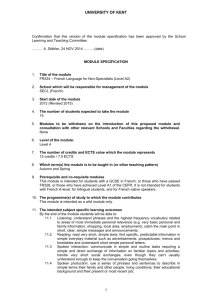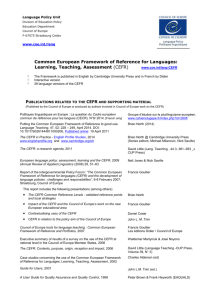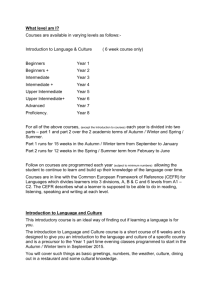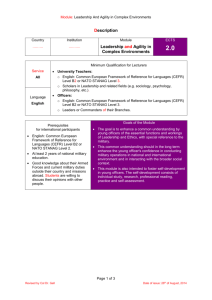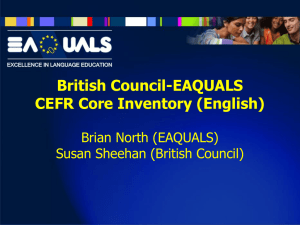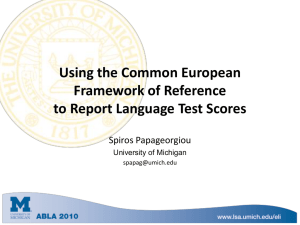4.3. The use of the CEFR
advertisement
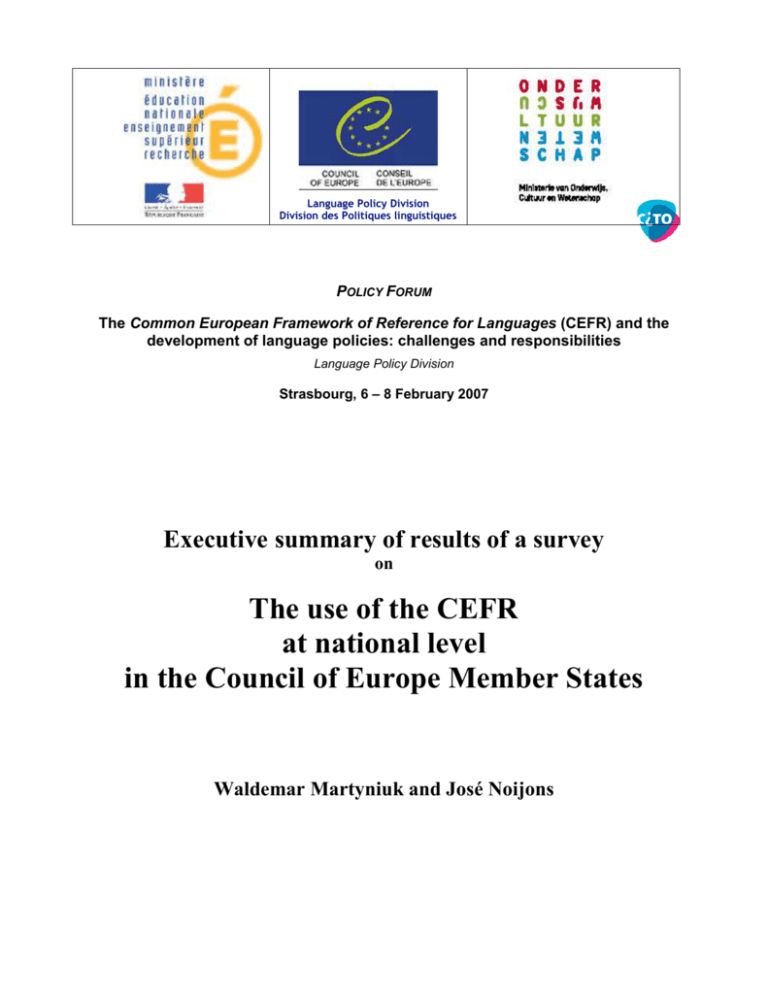
Language Policy Division Division des Politiques linguistiques POLICY FORUM The Common European Framework of Reference for Languages (CEFR) and the development of language policies: challenges and responsibilities Language Policy Division Strasbourg, 6 – 8 February 2007 Executive summary of results of a survey on The use of the CEFR at national level in the Council of Europe Member States Waldemar Martyniuk and José Noijons 1. Introduction The Common European Framework of Reference for Languages (CEFR), a document published by the Council of Europe’s Language Policy Division in 2001, the European Year of Languages, is being increasingly consulted and used in a wide number of contexts. A preliminary survey carried out in May 2005 provided a general overview of the use of the CEFR at institutional level.1 The purpose of the present survey, conducted between May and September 2006, was to gather information about the use of the CEFR at national level in as many of the 46 member states of the Council of Europe as possible. One questionnaire was to be filled in for each country. The questionnaire was short and brief answers were encouraged. However, space was provided for comments if there was a need to elaborate on the response. The results of the survey will serve as an input document during the Policy Forum The Common European Framework of Reference for Languages and the development of language policies: challenges and responsibilities organised by the Language Policy Division, Directorate of School, Out-of-School and Higher Education (DG IV), Council of Europe, in close co-operation with France and the Netherlands (Strasbourg, 6-8 February 2007). 2. The questionnaire The following questions and requests for information were included in the questionnaire that was sent to the Member States: 1. Has the CEFR been translated into the/an official language of your country? If not, are there plans to do so? 2. Is there a specific reference to the Council of Europe CEFR (approach, levels, scales, descriptors, etc.) in any official documents (e. g. ministerial decrees, national curricula, examination guidelines) issued in your country? 3. Please estimate how useful the CEFR has proved to be so far in your country for the following purposes and contexts: 3a. The planning and the development of curricula/syllabi in any of the educational sectors (primary, secondary, higher, vocational, adult); 3b. The planning and the development of teacher education/training; 3c. The planning and the development of testing / assessment / certification in any of the educational sectors (primary, secondary, higher, vocational, adult); 3d. Any other contexts (to be specified). For each of these areas of use (3a – 3d) the respondents were asked to provide more specific information on: 1 A summary of the results may be viewed at www.coe.int/lang and www.coe.int/portfolio 2 Examples of use (reference to the CEFR: action oriented approach, focus on language learner as language user, competence profiles, partial competences, diversification of languages on offer; link/reference to the CEFR levels, use of descriptive categories, descriptors, scales, etc.); Problems encountered, if any; Solutions adopted, if any; Future plans with reference to the use of the CEFR for this purpose; Needs for further developments / forms of co-operation / tools / instruments, if any. 4. Please summarise the needs mentioned under 3a – 3d ranking them from the most urgent to the less immediate. 5. Please summarise the impact of the CEFR on language education in your country – as you see it. 6. Please estimate how useful the following documents related to the CEFR have proved to be so far in your country: a. Common European Framework of Reference for Languages : Learning, Teaching, Assessment – Guide for Users b. Common European Framework of Reference for Languages : Learning, Teaching, Assessment – Case Studies c. Manual (Preliminary Pilot Version) for Relating Language Examinations to the Common European Framework of Reference for Languages: Learning, Teaching, Assessment d. Guide for the development of language education policies in Europe – From linguistic diversity to plurilingual education e. European Language Portfolio – Guide for ELP developers f. European Language Portfolio – Guide for Teachers and Teacher Trainers g. Other related Council of Europe documents (to be specified) 3 3. The respondents Responses from the following 30 Council of Europe member states were received by 09.10.2006: 1. Albania 2. Armenia 3. Austria 4. Belgium – Flemish speaking community 5. Croatia 6. Cyprus 7. Czech Republic 8. Finland 9. France 10. “The former Yugoslav Republic of Macedonia” 11. Germany 12. Greece 13. Hungary 14. Italy 15. Liechtenstein 16. Lithuania 17. Moldova 18. Netherlands 19. Norway 20. Poland 21. Romania 22. Russian Federation 23. Serbia 24. Slovak Republic 25. Slovenia 26. Spain 27. Sweden 28. Switzerland 29. Turkey 30. United Kingdom 4 4. The results – a summary 4.1. Translation of the CEFR The CEFR is now available in 36 language versions worldwide. Survey respondents from five countries indicated that the CEFR has not yet been translated into the local language, while in three of them the translation is either in progress or planned in the nearest future. 4.2. Reference to the CEFR in official documents The survey shows that the CEFR is frequently referred to in a variety of official documents at state and regional level, such as: National curricula for foreign languages at Primary and Secondary Level Language curricula for Higher Education Curricula for bilingual education and education in minority languages Examination/Assessment/Certification guidelines and requirements Language teacher education curricula In-service teacher training programmes Recommendations on the use of the European Language Portfolio Guidelines for the development of language textbooks Language requirements for migrants applying for residence permit Language requirements for civil servants Strategy documents and action plans related to language education. 4.3. The use of the CEFR The CEFR has proved to be most useful for the planning and the development of curricula/syllabi – respondents from 26 out of of 29 states (90%) found it very useful or rather useful for this purpose. A similar evaluation was given to the usefulnes of the CEFR for the planning and the development of testing / assessment / certification, with respondents from 26 out of 30 states (87%) viewing it as very useful or rather useful here. Respondents from 21 out of 27 states (78%) who filled in this part of the questionnaire rated the CEFR as very useful or rather useful for the planning and the development of teacher education/training. 4.4. The use of CEFR-related documents In their evaluation of the usefulness of six CEFR-related Council of Europe documents, most respondents preferred the two guides accompanying the European Language Portfolio – the Guide for ELP Developers was found very useful or rather useful by almost 93% of voters followed by the ELP Guide for Teachers and Teacher Trainers (ca. 82%). 74% of the respondents rated the CEFR Guide for users as very useful or rather useful, the preliminary draft of the Manual for relating language examinations to the CEFR was rated useful by 67% of the respondents and the Guide for the Development of Language Education Policies by 63% of them. The final document – the CEFR Case Studies seems to remain less known to the users of the CEFR – 41% of the respondents found it useful but the same number indicated that it is not used at all or were not able to give any rating here. 5 4.5. The use of the CEFR in specific contexts 4.5.1. The planning and the development of curricula/syllabi The responses show that the CEFR has influenced the development and planning of a number of curricula for primary, secondary, upper secondary schools or adult and higher education. The impact is not equal in all the countries and may vary from partial to global influence. The countries point out that most use was made of elements of the Framework such as the learner-centered actionoriented approach, the scenarios for a diversification of languages on offer, the concept of lifelong learning, as well as the promotion of plurilingualism and pluriculturalism. Several countries advocated the use of descriptive categories, descriptors and scales and the portfolio approach as a strategy for self-evaluation. Issues related to the use of the common reference levels, such as a need for defining additional sub-levels and the repetitiveness and lack of detail of some descriptors were indicated as the most acute problems by a majority of countries. Some mentioned the hesitant attitude to the CEFR in teaching circles, the reluctance to accept the concept of partial competences and also the lack of descriptors for mediation and translation skills as possible obstacles. The solutions adopted here were mostly creative in character. The countries created sublevels, questionnaires to identify teachers’ and students’ needs and even databases with model tasks for CEFR descriptors and linked syllabi to the CEFR through examinations. Others organised education seminars to improve teachers’ competences and exchange good practice as well as to raise parents’ awareness. In several countries, reference materials, standards and examinations are being revisited, updated and it is intended that they will be based on the CEFR in the near future. Some countries are also planning to pursue work concerning empirical validation of the links between the national syllabi and the CEFR. Others plan to support the development of more detailed language descriptors and teacher-training programmes. 4.5.2. The planning and the development of teacher education/training It is difficult to summarise conclusions from responses related to the use of the CEFR in this area. The spectrum of use is quite wide: in some countries the CEFR is used for the entire preservice and in-service teacher training, in others only for CEFR-based teacher training and in some others there is no definite information available. However, the overall impression gained from the responses is the following: the CEFR was mostly useful in terms of levels, scales and descriptors and for defining the language proficiency of teachers. Better cooperation at international level was requested, leading towards more “standardised”, comparable and compatible outcomes for preservice teacher training courses. Lack of dissemination and as a result teachers not being familiar with the CEFR itself was the most frequently mentioned problem. Another issue raised quite frequently was the complexity of the document that makes it difficult to access its descriptive scheme and methodological approach. The theoretical concept of the CEFR seems to be quite complex and challenging also. The solutions found here were not numerous but mostly concerned the reinforcement of education based on the CEFR, teacher training and demonstration of good practice. One country proposed looking for assistance from other stakeholders such as publishers. 6 Most countries are planning to continue encouraging wider use of the CEFR and of the Guide for the Development of Language Education Policies. Some plan to organise more in-service teacher training as well as to pursue general promotion of the CEFR for teachers’ in-service education and syllabus development. 4.5.3. The planning and the development of testing / assessment / certification The overall impression is that the majority of countries have already been trying to implement the CEFR for some time in the development of tests and examinations either for primary and secondary schools or for adult education. The idea that language learners can only benefit from a mutual recognition scheme for qualifications and from a reference system for communication concerning learning objectives and achievements finds wide support. Some examinations and/or tests are already either related to the levels of the CEFR or adjusted to them. The remaining countries can be divided into those planning to use the Framework for this purpose in the near future and those not intending to do so at the moment, with the latter being a very small minority. Most countries emphasised the usefulness of the levels, proficiency descriptors and scales. In addition to the lack of precision in some of the level descriptors, the countries identified the difficulty of linking tests to the CEFR as another pressing issue. The conservative mentality of teachers as well as the need to involve parents were also mentioned as issues to be taken into account in the process of the implementation of the CEFR. The solutions found here were to organise workshops on the use of the CEFR, analyse the existing exams by mixed teams of teachers and experts and to provide teachers with more training in implementing the CEFR. The future plans refer mainly to linking exams and national syllabi to the CEFR or working on empirical validation of the links. Other planned activities include further dissemination of the ELP at schools, work on developing more illustrative descriptors or on creating sample tests illustrating various competences. 4.5.4. The use of the CEFR in other contexts Those who referred to the use of the CEFR in other contexts than the three areas mentioned above singled out the usefulness of the CEFR as a basis for the European Language Portfolio and for writing course books and materials. Problems that were mentioned here were highly individual – such as those caused by the lack of a translation of the Framework into the local language, or those related to the implementation of the ELP as a tool for plurilingual education. Solutions were only offered by two countries here. These were to raise awareness of the CEFR, to elaborate a glossary and to translate the CEFR. 4.6. Summary of the overall impact of the CEFR In general, the CEFR seems to have a major impact on language education. It is used – often as the exclusive neutral reference – in all educational sectors. Its value as a reference tool to coordinate the objectives of education at all levels is widely appreciated. Respondents indicate that the Framework is well known by the institutions in question and quite well accepted by the majority of teachers. In some countries the CEFR has helped to develop both strategic language policy documents and practical teaching materials. In others, it is becoming the most reliable reference for 7 curriculum planning. Some respondents stress that the CEFR has made the communicative approach to language teaching more action-oriented. On the other hand, some respondents view the CEFR’s impact as quite modest so far. They point out that it does not yet play an important role for the teaching profession at the school level, although it has undeniably contributed to more transparency and coherence in general. These respondents find that the full potential of the CEFR has not yet been realised, partly due to the fact that it is still not very reader-friendly and a greater effort is needed to mediate it to users. They stress the need for general clarification (such as comments on theoretical concepts, examples and good illustrations, sets of tasks for use in specific contexts, a bilingual terminology glossary for each country), as well as the need to familiarise more teachers with the document by organising national and international events, exchanging good practice, etc. . 4.7. General comments provided by respondents In question 7 countries were encouraged to come up with any comments on the CEFR. These were not numerous and they focused mostly on the needs related to the use of the document such as: - the need for a concise and reader-friendly summary of the CEFR and of the basic principles of its approach - the need to calibrate national syllabi to the CEFR - the need to develop tests calibrated to the CEFR levels for different age groups - the need for a forum for an exchange of good practice related to the use of the CEFR. 4.8. Needs related to the use of the CEFR in different contexts An important aim of the survey has been to produce a (priority) list of needs related to the use of the CEFR in the different contexts of language education. Questions 3a-3d, section 5 in the questionnaire asked member states to list the needs perceived in each context. Question 4 was aimed at prioritising the needs. While the potential of the CEFR appears to be quite widely acknowledged and appreciated, there seems to be a considerable and quite urgent need to develop user-friendly sets of materials for mediating the CEFR to the different stakeholder groups: policy makers, curriculum developers, textbook developers, publishers, teachers, testers, parents of learners, employers. There is also a strongly felt need for national and international cooperation in interpreting and using the CEFR. Countries also indicate that there is a strong need for the creation of training materials in all areas where the CEFR is used and has been found to be useful – curriculum development, teacher education, elaboration of textbooks, assessment. Such materials could include, for example, a guide on how to develop a CEFR-based curriculum or a training kit for the development of CEFR-based tests. In addition, CEFR-based tests and benchmarks to illustrate what performances at CEFR-levels entail should be produced. Similarly, banks of test items for language skills at specific levels are required. Finally, it would be helpful to fine-tune the descriptions of certain CEFR-levels and to make them more age-specific. 8
